Tue Aug 12, 2014 12:45 PDT
Lenders emerge to break the bounds of QM guidelines
Seven months after the Consumer Financial Protection Bureau (CFPB) defined what a qualified mortgage (QM) is, several lenders have rolled out products outside its bounds.
Over the past few weeks, Impac Mortgage Corp. and RPM Mortgage Inc. have debuted products aimed at borrowers who might not fit the QM profile, with both companies citing a need in the market and confidence that their underwriting will be strict enough to keep everyone protected.
RPM’s products target upper-income borrowers who have trouble documenting income, like retirees and the self-employed who may have big investment portfolios or already own property. In some cases, a borrower could get as much as 80 percent on loans between $250,000 and $4 million.
“RPM primarily serves a lot of the high-end market, and many of our clients are locked out of the market from refinancing or purchasing because they do not fall within the QM guidelines,” RPM CEO Rob Hirt told Scotsman Guide News.
Impac has dubbed its line of products “ alt QM.” The offerings include an alternative agency product outside of Desktop Underwriter and Loan Prospector guidelines and a 50 percent debt-to-income (DTI) allowance; a product for self-employed borrowers; a jumbo product with higher DTI and a $3 million limit; and a product for real estate investors with more than 10 properties, outside of government-sponsored enterprise (GSE) limits.
“These loan programs are sorely needed because there’s an underserved market,” Impac President Bill Ashmore told Scotsman Guide News.
The cost of the RPM loan products range from mid-4 percent to mid-5 percent, depending on creditworthiness and assets, Hirt said. Ashmore said that Impac’s products will range from 5 percent to 6 percent.
These products differ from the non-QM jumbo loans that big banks offer to wealthy borrowers — and have offered since the QM standard went into effect — because they may end up serving a more diverse set of borrowers, like those with a sub-720 credit score.
Legal footing
These alternative QM lenders say they are not overly concerned about legal trouble because they will stick to underwriting standards as defined by the ability-to-repay (ATR) rule and will offer good customer service.
A benefit to producing QM loans is legal protection. The presumption is that if a lender followed ATR and QM guidelines, they did everything they could to prepare the borrower and thus bear little or no legal responsibility for a default or foreclosure.
This “safe harbor” is the most legally ironclad QM loan, while the separate “rebuttable presumption” QM type offers slightly less legal protection. According to the CFPB, a borrower could prevail in a rebuttable presumption suit if “the creditor did not consider their living expenses after their mortgage and other debts.”
RPM is building legal costs into the price of loans, Hirt said, but added that any borrower can take any lender to court over any loan, QM or not.
“There’s always something someone can challenge in court if they want to. Non-QM is not any different. How we are rationalizing our underwriting criteria will prevail if we are going so far in court,” Hirt said.
Impac will use ATR guidelines in underwriting all but one of its loan types. The investor product, Ashmore said, is essentially a business loan, which ATR does not cover. Ashmore also pointed out that some alternative programs could produce QM loans if the borrower, for example, has below 43 percent DTI and does not opt for an interest-only loan.
“When you’re going to get sued on a loan is when the borrower is not making payments. We believe the loans we are making are a 680 [FICO score] or above. These loans will perform,” Ashmore said. “I’m not really worried about getting sued.”
Hope in growing market
A recent National Association of Realtors (NAR) survey found that non-QM products are still relatively rare. NAR found that non-QM lending accounted for just 1.6 percent of production among respondents. Even the relatively safer rebuttable presumption loans accounted for just 8.3 percent of production.
Sixty-eight percent of respondents, however, said that their reluctance to originate non-QM was not because of regulators, but because of investors. Industry experts generally agree that without a larger private-label securities market, there will not be a large non-QM market.
Ashmore predicts that investors will inevitably look for a higher-yield product like what Impac is offering, and that the subordination of non-QM loans will settle.
Hirt argued that there is a “well-qualified market starving for liquidity” out there, which non-QM products will serve. Hirt projects that 20 percent of originations will eventually be the result of RPM’s alt-QM products.
“We have 65,000 unique clients in our databases. In reviewing the historical loan types of our past clients, we saw up to 20 percent of them could take advantage of these products,” Hirt said.
“It’s a huge underserved market that eventually will be billions in size,” Ashmore said. “A key indicator of the health of the U.S. economy is a healthy real estate [market]. Right now, it is sputtering out there. There are many borrowers on the sidelines.”
Questions? Contact Neal McNamara at (425) 984-6017 or nealm@scotsmanguide.com.
Scotsmanguide



